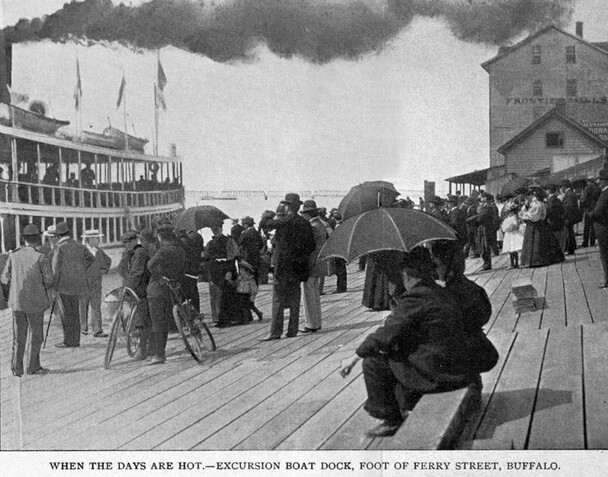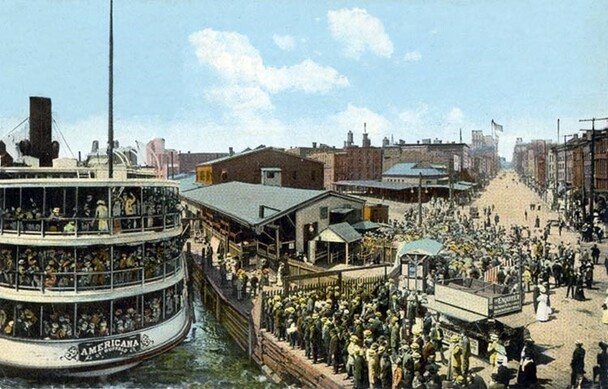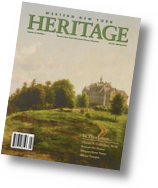The Strangling of Buffalo
How Hundreds of Thousands of Summer Excursionists Have Taken Their Lives in Their Hands in an Endeavor to Get a Modest Day's Outing
The Buffalo Express August 20, 1908
The local excursion season is practically closed for this year.
That it has ended without any serious accidents is a matter upon which Buffalonians may be congratulated. The excursion terminal facilities - or rather lack of facilities - offer every condition necessary for a daily tragedy. That we have escaped them is our good fortune.
The Express says this without any wish to knock. It has had no desire to interfere with the pleasure which the people of this city should find in their daily outings by rail or water; for that reason it has refrained until now from emphasizing what everyone here knows to be the fact - that Buffalo has the worst excursion docks as well as the worst railroad stations of any city its size in the country.
There is no exception to this statement, broad as it may seem. Anyone who has tried to get out of Buffalo by way of the Main Street dock knows that conditions there could not be much worse than they are, even if some evil genius tried to make them so. People really take their lives in their hands every time they try to board a boat at that point. This is especially true when there is a rush, and a rush is so common as to be the ordinary occurrence. The docks are limited in extent and there are absolutely no facilities for keeping a crowd in order. All summer long Main Street has been blocked by the trains of the Lackawanna Railroad, oftener than it has been open to traffic. Trains have either stood across the street or have been switched back and forth without any regard whatever for the convenience of the people or their safety...
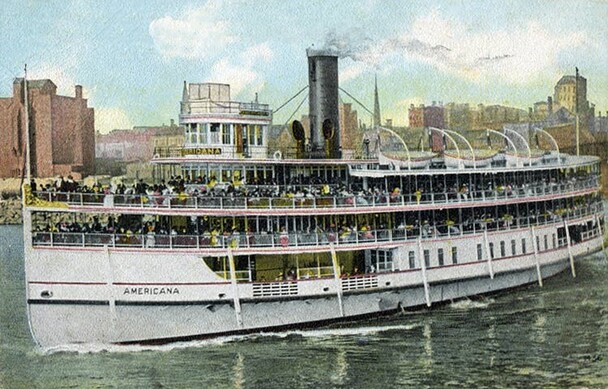
The Americana, launched in 1908, leaves the Buffalo harbor bound for Crystal Beach. Image source: private collection.
What is true of the foot of Main Street is likewise true of those points where boats are taken for down the river and to Fort Erie. Dangerous approaches, no adequate facilities for caring for the crowds - these are the features of all of these points...
Buffalo is a beautiful city - so beautiful that many people come from afar to visit it during the summer weather. And so delightful is its climate, here along the shores of Lake Erie, that many folk who live here do not go away at all for the summer, but stay at home from choice, to enjoy the pleasant weather without giving up the comforts of their city homes and the trim fairness of the long arches of trees over asphalt pavements - these and the opportunities for little jaunts to spots of interest in which the country abounds. For there are many delightful excursion poitns within easy reach of the one-day excursionist...
...Suppose the summer excursionist decides to go down the river. He makes his way to Ferry Street, where he falls in with such crowds at the excursion hours as are not found on any other street in the city with the exception, perhaps, of Main and Exchange Streets. Bustling, hurrying, bent on catching something, whether boat or train, they surge along in two living streams.
At the end of a steep down grade, where boards jump and rattle in the narrow, old, rickety plank walk, lies the river, with the canal parallel to it. At the foot of the hill the roadway is jammed with automobiles, carriages, vans, wagons, peanut carts and every kind of vehicle imaginable. They are waiting, and as they wait and wait, they fume and frown and crowd and jostle and the pedestrians assemble and the pack grows more and more dense.
It happens that the draw on the bridge is swung open for a couple of craft to pass through, and the whole river traffic and the ferry traffic for Fort Erie are held up until the bridge can be replaced. And the little ships at the dock steam and puff and the people grow worried and impatient.
The draw is in place again, and up a steep incline and down to the tiny dock the crowd pours, until the strip of solid footing that serves for a dock is packed with people. Somebody, in the scramble, falls flat and the crowd pushes on, to the danger of the fallen one - for there are many steep and narrow, rickety bits of old walk. Into a little pen the river-boat passengers are thrust, the boas arew rapidly crowded, and the jam lessens for a while. Between the canal and the river is a strip no wider than the sidewalk on a village main street, and upon this strip the people are crowded, with horses, automobiles and almost every element of danger that the case could suggest.Some of the river-boats land at the foot of Hertel Avenue and Amherst Street, in the lumber district, where the travelers, mostly pleasurers who like pleasant surroundings, and are bound for the clubs or parks of the river, or returning thence, seek the landing point through a maze of lumber piles which, on a dark night, make the locality neither delightful nor safe.
The Crystal Beach boats come in at the foot of Main Street. Hurrying, scurrying go the merry stragglers. The gates are shut and the big boat swings without. It is not time yet and the crowd gathers. Bustling people, too excited to look right or left, join the outer edge, pushing the crowd closer. The Lackawanna Railroad tracks cut across Main Street here, cutting the dock space to almost nothing. Of course, the crowds overflow this tiny space, the engines shunt back and forth, and long lines of freight cars obstruct the way, it is a wonder that any of these pleasurers live to tell the tale. Under a car somebody darts, so eager to catch the boat that he never stops to think that the train might start. The sun shines hot, and the crowds bake therein, for there is not cover or shelter from either that or rain - nothing but a cage like a cattle pen.
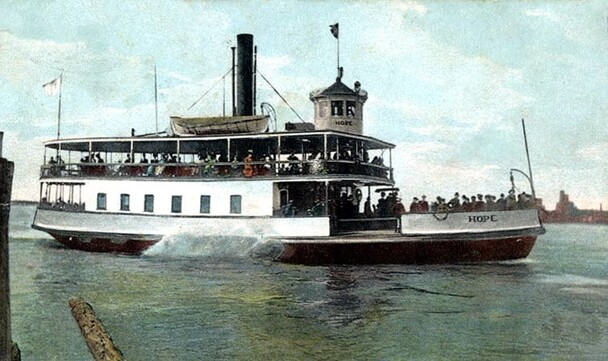
The ferry Hope on its route between Ferry Street and Fort Erie, ca. 1900. Image source: private collection
At the foot of Washington Street, where great elevators tower aloft and the very air is thick with dust and grime, big lake boats come to dock. Here it is really safer to land by daylight, for many and unexpected are the holes and open slips that yawn for the unwary. Again, there are the tracks to be crossed. Here, in this dirty, squalid locality, the waiting passenger must wander until his boat is ready, and here the new arrival forms a lasting impression. "Surely," says he, "I have found a city where comfort and culture are unknown."
